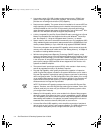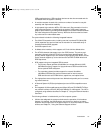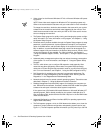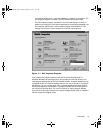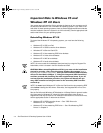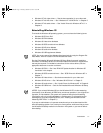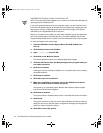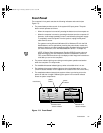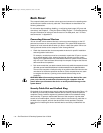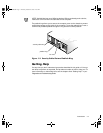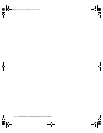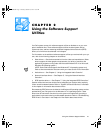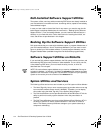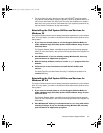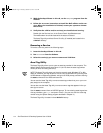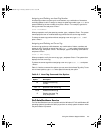
1-10
'HOO3UHFLVLRQ'HVNWRS6\VWHPV8VHU©V*XLGH
%DFN3DQHO
The computer’s back panel contains various ports and connectors for attaching exter-
nal devices and includes a security cable slot. These features are described in the
following subsections.
For information about enabling, disabling, or configuring input/output (I/O) ports and
connectors, see Chapter 3, “Using the System Setup Program.” For detailed descrip-
tions and illustrations of each port and connector on the back panel, see “I/O Ports
and Connectors” in Appendix B.
&RQQHFWLQJ([WHUQDO'HYLFHV
You can connect various external devices, such as a mouse and printer, to the I/O
ports and connectors on the computer’s back panel. The system BIOS detects the
presence of most external devices when you boot or reboot the system. When con-
necting external devices to the computer, follow these guidelines:
Check the documentation that accompanied the device for specific installation
and configuration instructions.
For example, most devices must be connected to a particular I/O port or connec-
tor to operate properly. Also, external devices like a mouse or printer usually
require you to load software files called
device drivers
into system memory before
they will work. These software drivers help the computer recognize the external
device and direct its operation.
Dell recommends that you attach external devices
only while the computer is turned
off
unless you are instructed otherwise in the documentation for the particular device.
Then turn the computer on before turning on any external devices unless the doc-
umentation for the device specifies otherwise. (If the computer does not seem
to recognize the device, try turning on the device before turning on the
computer.)
&$87,21:KHQGLVFRQQHFWLQJH[WHUQDOGHYLFHVIURPWKHEDFNRIWKHFRP
SXWHUZDLWWRVHFRQGVDIWHUGLVFRQQHFWLQJWKHFRPSXWHUIURP$&
SRZHUEHIRUH\RXGLVFRQQHFWWKHGHYLFHWRDYRLGSRVVLEOHGDPDJHWRWKH
V\VWHPERDUG
6HFXULW\&DEOH6ORWDQG3 DGORFN5LQJ
On the back of the computer are a security cable slot and padlock ring (see Figure 1-3)
for attaching commercially available antitheft devices. Security cables for personal
computers usually include a segment of galvanized cable with an attached locking
device and key. To prevent unauthorized removal of the computer, loop the cable
around an immovable object, insert the locking device into the security cable slot on
the back of the computer, and lock the device with the key provided. Complete
instructions for installing this kind of antitheft device are usually included with the
device.
23186bk0.bk Page 10 Thursday, October 29, 1998 11:07 AM



